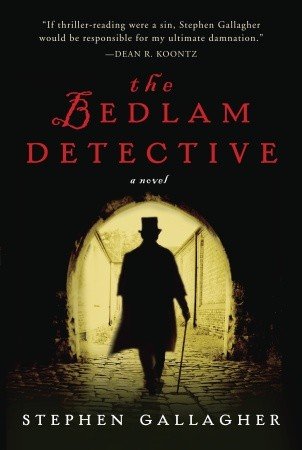 My frequent readers will no doubt sigh and shake their heads at me for reading another English Victorian – set novel to do with murder and madness. I know what I like – what can I do? But this book was different. While it used the framework of a Victorian sensational novel (although it’s technically set in the Edwardian), it brought with it a modern sensibility and told a good yarn.
My frequent readers will no doubt sigh and shake their heads at me for reading another English Victorian – set novel to do with murder and madness. I know what I like – what can I do? But this book was different. While it used the framework of a Victorian sensational novel (although it’s technically set in the Edwardian), it brought with it a modern sensibility and told a good yarn.
The main character, Sebastian Becker, has landed a post as the Lord Chancellor’s Visitor in Lunacy. In short, his job is to investigate the sanity of the landed gentry, those with wealth and power bestowed by the Crown. Should they be found wanting in rationality, their title may be stripped and given to the next in line. A strange job, to be sure, and no less adventurous than his previous occupation as a Pinkerton detective in America (a story I hope Gallagher explores in other books). Much like Jonathan Harker, Esq. in Dracula, Becker arrives in an unfamiliar rural town and is met with locals who refuse to talk of their troubled past. They are suspicious of this outsider and assume his unexpected visit can portend nothing good. Indeed, shortly after his arrival, two young girls disappear, only to be found dead hours later. And their unfortunate end is not the first horror experienced by this beachside community. But do they have anything to do with a madman? Is he mad at all?
Becker’s quarry is one Sir Owain Lancaster, lord of Arnside Hall. He’d always been a bit of reckless adventurer, but his latest stories were simply too wild to be believed. I minor inventor, he’d set out in the Amazon to develop a special device for navigating by the stars. But his travel party, including his wife and young son, is decimated in the dense forest. Sir Owain returns with just one survivor — and an unbelievable story of horrid monsters. Insistent, he presents his findings to the public, but some call his sanity into question, the the Crown calls upon Becker.

This lone survivor from the failed mission, Dr. Sibley, is Renfield, Igor and Smithers all in one. He pretends to be Sir Owain’s caregiver, but arouses suspicion. Gallagher introduces him as, “Not so much a man more a slimy shadow. Hanging around in the corner like an undertaker’s mute.” Like everyone else in this town, he is hiding something.
Gallagher artfully brings the past to life by inserting certain details. Film and photography were still in their infancy and the images that were produced had strange effects on their observers. Since little about how it worked was understood by the general populous, just about anything captured on film has to be “real” (i.e. The Cottingley Fairies). Found at the scene of the crime was a small film camera, with film in it. Becker knows it may contain evidence and brings it to local photographer for developing. The studio is described as
at the top of the house, containing attic space and a large skylight. It was reached by a gloomy staircase through the photographer’s living quarters. His private rooms were screened off by a red velvet curtain with braid and tassels, like the dressing on a Punch and Judy booth. Sebastian ascended through the chemical odors of the photographer’s trade, musty and unnatural, and the boiled-cabbage fragrance of his midday meal, even less appetizing.
But even more enjoyable is his inclusion of the traveling fair. Needing a place to view the film once developed, Becker approaches a Bioscope movie tent projectionist.
In this cramped room, dominated by the projection apparatus and smelling of ozone and naptha and nitrates, a young man was cranking the handle to rewind a film spool for the next show. … There was a bench down one side of the wagon. Strips of moving picture film hung from clotheslines above it, all of differing lengths, stirring in the draft from the door like the tails of so many kites. Mental film cans were stacked high on every surface, and on the wall a large hand-painted notice warned of the dangers of sparks and naked flames.
But where does imagination end and discovery begin? The Bedlam Detective tries to define where Victorian idealism meets prehistoric savagery, in the name of science and colonialism. In Becker’s case, he is charged with treating madness as something in need of domestic protection. But Gallagher seems to be noting that herding lunatics is just another form of colonialism — another’s idea of normalcy impressed upon a disparate population. That, and a gentle reminder that monsters can come in many disguises.
Many thanks to Mary at Crown Publishing for the review copy.
_______________________________________
Hardcover: 320 pages
Publisher: Crown (February 7, 2012)
Language: English
ISBN-10: 0307406644
ISBN-13: 978-0307406644
Dimensions: 6.6 x 1.2 x 9.6 inches

Great review! I particularly love this line “The Bedlam Detective tries to define where Victorian idealism meets prehistoric savagery, in the name of science and colonialism.”.